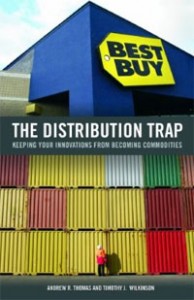The Trouble with Mass-Market Distribution

Not according to professors Andrew R. Thomas, of the University of Akron, and Timothy J. Wilkinson, of Montana State University Billings. In 2006, Thomas and Wilkinson wrote an essay in MIT Sloan Management Review called “The Outsourcing Compulsion,” in which they argued that the power of mass-market “megadistributors” — whose clout enables them to seek price concessions from their vendors — practically force U.S.-based companies who distribute through the “megadistributors” to outsource manufacturing overseas to meet the retailers’ pricing requirements. And in 2007, the authors explored a related theme — the benefits for manufacturers of controlling their own distribution — in “The Distribution Trap,” an article for MIT Sloan Management Review’s collaboration with The Wall Street Journal.
Now Thomas and Wilkinson have expanded on these themes in a book they published this year called The Distribution Trap: Keeping Your Innovations from Becoming Commodities. In it, they make the argument that for many companies that sell consumer products, mass-market distribution can be problematic. They write:
“Mistakenly, many companies see deals with Mega-distributors as the way to boost sales and market share. In reality, the Megas, as we call them, live by high volume and low prices. The Megas use their powerful leverage to demand price cuts and other concessions from their suppliers. Companies end up with thin profit margins, and their innovative products and services are often treated as little more than commodities.”
